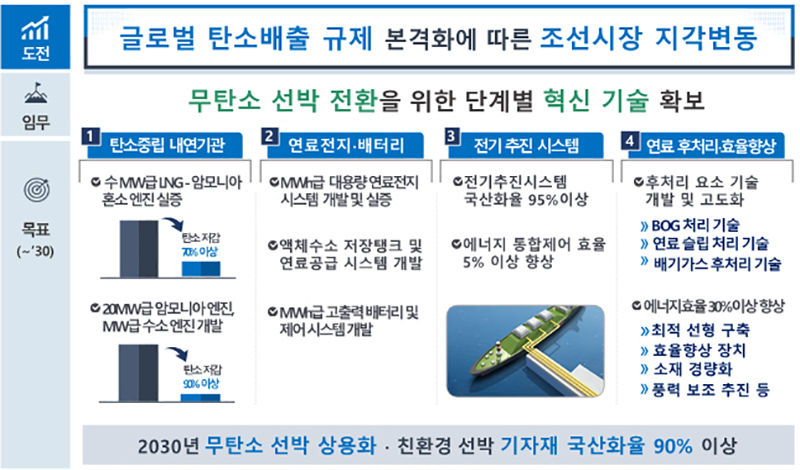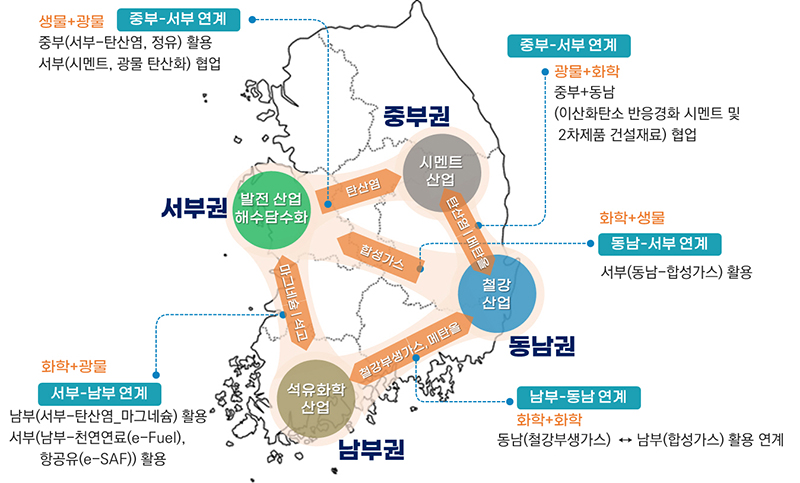Promoting ‘CCU Flagship Projects in 4 Major Regions’ to achieve NDC in 2030
In order to achieve the National Greenhouse Gas Reduction Target (NDC) in 2030, the government will first promote ‘CCU flagship projects in four major regions’ targeting key technologies.
Featured Photo: Perspective Image of the 1MW Grade Eco-friendly Technology Sea Trial Test Ship (K-GTB). Source: KOREA RESEARCH INSTITUTE OF SHIPS & OCEAN ENGINEERING – link
In particular, we have established a technology development strategy aimed at commercializing carbon-free ships and achieving a localization rate of over 90% of eco-friendly ship equipment by 2030.
The Ministry of Science and ICT held the 8th meeting of the ‘Carbon Neutral Technology Special Committee’ under the National Science and Technology Advisory Council on the 19th, and presented the ‘Carbon Neutral Technology Innovation Strategy Roadmap’ and ‘CCU Technology’ in the fields of carbon neutral ships, zero energy buildings, and solar power. Announced ‘Sophistication Strategy’.
Accordingly, in order to promote a strategy to advance carbon dioxide capture and utilization (CCU) technology, CCU flagship projects (Yeta) in each of the four major regions will be promoted for key technologies, and public-private joint investments will be supported to foster industrial strategic technologies.
In addition, we plan to combine research capabilities between national research and government-funded research institutes for future innovative technologies and create an institutional foundation for next-generation new industries.
◆ Carbon neutral technological innovation strategy roadmap (draft)
The government plans to use this roadmap as a blueprint for government R&D investment in the carbon neutral field, and plans to periodically revise and supplement it to reflect technology and policy changes to ensure that necessary support is provided in a timely manner.
In particular, in order to respond to recent changes in domestic and international policies for carbon reduction, a technology innovation roadmap was presented in three areas that require urgent technology development: carbon neutral ships, zero energy buildings, and solar power.
A carbon-neutral ship refers to a ship that uses zero-carbon fuel or processes CO2 resulting from the use of low-carbon fuel, resulting in zero net carbon emissions.
In a situation where the carbon neutral trend in the global shipping market is accelerating as the International Maritime Organization (IMO) begins to implement environmental regulations for existing ships starting this year in addition to environmental regulations for new ships, rapid technology development is required.
Accordingly, in order to commercialize carbon-free ships and achieve a domestic production rate of eco-friendly ship equipment of over 90%, we have internalized core equipment technology for carbon-neutral ships and secured a track record for installation on ships by linking with verification under sea conditions from the technology development stage. I plan to do it.
First, we support research and development to replace internal combustion engines for ships that use existing fossil fuels and internalize internal combustion engines and core component technologies that use low-carbon fuels such as LNG or methanol or non-carbon fuels such as ammonia and hydrogen.
In addition, it is a technology for using fuel cells or batteries using carbon-free fuels such as hydrogen or ammonia as a power generation source for electric propulsion ships. It is designed to increase capacity by applying fuel cells and batteries to ships to secure sufficient operating distance and use them safely. and optimization technology will be developed.
In particular, we will pursue internalization of key component technologies to secure the performance of electric propulsion systems, such as semiconductor circuit breakers, power conversion devices, and propulsion motors.
We are also developing energy efficiency improvement technologies to reduce the energy required during operation, such as optimal linear design technology for ships and friction reduction technology.

Key contents of technology innovation strategy roadmap (draft) in the carbon-neutral shipping sector
The zero energy building sector has established a goal of reducing greenhouse gas emissions in the building sector by more than 30% compared to 2018 by 2030.
To this end, an all-round technological innovation plan is being promoted, including building envelope and equipment, new and renewable energy convergence, and building energy management based on building data.
In particular, considering the fact that basic buildings account for 95% of domestic buildings, we focused on technologies that can enable efficient energy management of buildings at an appropriate cost.
Accordingly, we are developing retrofit technology that can be used in existing buildings, along with lighting, shading, and insulation technologies to minimize energy lost from the building envelope.
We will electrify the current fossil fuel-based cooling, heating, and domestic hot water facilities based on heat pumps and develop control technology to optimally operate the heat source facilities within the building through systematic management.
In addition, we will use building-linked renewable energy to increase the electric and thermal energy self-sufficiency of buildings, and further develop technology to enable optimal operation by sharing surplus energy between buildings at the community level.
Using ICT technologies such as digital twin-based building autonomous driving technology and virtual sensors, we develop technology to efficiently operate energy by collecting, analyzing, and diagnosing data on energy produced, operated, and consumed in individual buildings.
Meanwhile, solar power generation is a technology that produces electricity by converting the sun’s light energy using the photovoltaic effect.
However, although the spread of solar energy has greatly expanded for the transition to eco-friendly energy, there is a need to develop leading technologies to dominate the next-generation market by increasing power generation efficiency and securing economic feasibility.
Accordingly, under the policy of reducing thermal power generation such as coal and LNG and expanding renewable energy such as solar power, the outlook for renewable energy supply was reestablished to a feasible level early this year.
Furthermore, we plan to set a reasonable renewable energy policy direction and promote the development of necessary technologies to ensure cost-effectiveness, increase acceptance by residents, and promote the spread of renewable energy along with domestic industrial development.
First, the goal is to develop ultra-high-efficiency solar cells (efficiency of about 36% or more) by using tandem technology, which maximizes efficiency by absorbing various wavelengths by stacking perovskite, a next-generation material, on silicon solar cells. .
In addition, in order to diversify the uses, we are also developing solar cells that can be applied to a variety of uses and increase efficiency through high efficiency, such as tandemization of thin film-based solar cells with the advantages of lightening and large area.
Considering domestic conditions where solar energy installation space is limited, we are developing system technology to diversify the use of solar energy to buildings, farming, water, transportation, etc., and developing multi-functional solar energy technologies such as lightweight and flood-type solar energy that are the basis for system application. develop.
In addition, as the spread of solar energy expands, we are supporting the establishment of a resource circulation system by developing technology to reuse and recycle waste solar modules that have reached their expected lifespan rather than incinerating or landfilling them.
◆ Carbon dioxide capture and utilization (CCU) technology advancement strategy (draft)
In accordance with the ‘CCU Flagship Project for each of the four major regions’, a CCU demonstration platform will be established in the western region to foster various industries and CCU technologies such as chemistry, biology, and mineralization.
The southern region is mainly linked to the chemical industry, which is a regional strength, while the southeastern region is linked to the existing steel industry to produce methanol from carbon dioxide emitted during the steelmaking process or alternative construction materials from slag.
In the central region, we plan to support the production of secondary construction products using carbon dioxide emitted from ready-mix concrete in connection with the cement industry, a regional specialty industry.

Overview of proven flagships in each of the four major regions
Compared to the market value or corporate demand expected in the future, currently immature technologies are quickly developed by calculating expected demand, and public-private joint investment is actively encouraged.
In addition, we plan to strengthen corporate support such as providing a technical information database, technology exchange, and technology matching by operating a CCU technical support group participated by government-funded research institutes, universities, and associations.
In particular, we plan to plan new national research projects to support future-oriented and challenging next-generation CCU technology.
New projects are initially operated in a tournament format that provides broad support to high-potential technology fields, but focuses support by evaluating commercialization potential at each technology development stage.
In addition, by designating a national CCU key research laboratory, we will secure world-class leading technology in each field and promote systematic international cooperation research and human resource training.
In addition, in order to create an institutional foundation, a CCUS integration bill will be prepared in consultation with relevant ministries, and in order to establish a national standard for CCU technology, technology standardization research support for commercialization linkage, including technology certification, and cooperation between related organizations will be promoted.

Key strategies
Joo Young-chang, head of the Science, Technology and Innovation Division of the Ministry of Science and ICT, explained, “We have been laying the foundation for carbon-neutral R&D through a mission-oriented carbon-neutral R&D system that presents clear goals and deadlines to achieve national goals.”
He continued, “Now, even in the field of carbon neutrality, we will provide policy support to secure next-generation innovative technologies that challenge the best on the world stage.”
Meanwhile, in accordance with the newly established carbon dioxide capture and utilization (CCU) technology advancement strategy (draft), the government will review whether the ‘CCU flagship projects in each of the four major regions’ are subject to preliminary feasibility studies and promote follow-up procedures without exception to achieve carbon neutrality. We plan to support CCU technology development.
Source: Ministry of Science and ICT, Policy news, link


Comments